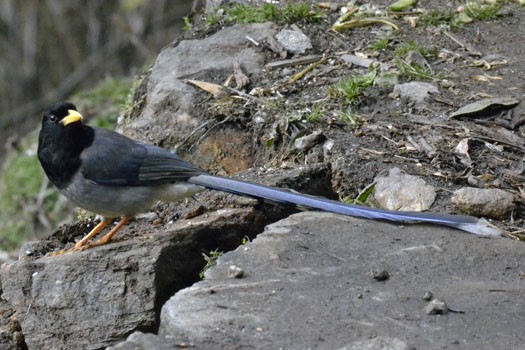Yellow-billed Blue Magpie
A species of Blue Magpies Scientific name : Urocissa flavirostris Genus : Blue Magpies
Yellow-billed Blue Magpie, A species of Blue Magpies
Botanical name: Urocissa flavirostris
Genus: Blue Magpies
Content
Description General Info
 Photo By Rathin ch kundu , used under CC-BY-SA-3.0 /Cropped and compressed from original
Photo By Rathin ch kundu , used under CC-BY-SA-3.0 /Cropped and compressed from original Description
Length 66 cm (26 in), including tail of about 46 cm (18 in). Sexes alike. Head, neck, and breast black, with a white patch on the nape; remainder of lower plumage white, faintly tinged with lilac; whole upper plumage purplish-blue, brighter on the wings and tail; flight-feathers tipped with white, the outermost edged with the same; tail long and graduated, the feathers blue, broadly tipped with white, all except the very long central pair having a band of black in front of the white 
Size
61 cm
Nest Placement
Tree
Feeding Habits
Yellow-billed Blue Magpie is omnivorous, primarily consuming invertebrates, small vertebrates, fruits, and berries, including raiding nests for eggs and nestlings. They forage at various levels, often in pairs or groups, and can become bold near temple offerings. Their feeding is akin to U. erythroryncha, utilizing forests floors to canopy.
Habitat
The yellow-billed Blue Magpie inhabits moist deciduous and mixed temperate forests characterized by the presence of oak, chestnut, conifer, and rhododendron species. These birds are commonly found at the fringes of forests, including areas near human settlements and agricultural terraces, as well as borders of tea plantations. The yellow-billed Blue Magpie is more associated with true forest environments than its relative, U. erythroryncha, and typically occupies these habitats throughout broader temperate regions.
Dite type
Omnivorous
General Info
Feeding Habits
Bird food type
Behavior
The blue magpies are, as may be judged from their handsome tails, essentially arboreal birds; though, while they are most usually to be met with in heavy jungle areas, they also venture out into the trees amongst cultivation, and at times on to bare mountain sides at high elevations. They frequently feed on the ground and then adopt a curious hopping gait, with the tail held high to prevent it coming into contact with the ground. They live in parties of seven or eight birds and are very partial to particular localities, so that once a party has taken up its abode in any particular nullah or patch of forest it will generally be found there. They are very active, flying incessantly from bough to bough and not hesitating to launch high into the air when flying from ridge to ridge; a party of these bird crossing a nullah out of gunshot above one's head is a curious sight, with their long tails waving in the air and the light shining through the feathers. The flight is rather slow, laboured, and undulating once the bird comes into the open. The food consists of small mammals, the eggs and young of other birds, insects, and wild fruits and berries of various kinds. This bird is very noisy; the ordinary call is harsh and grating, but it has a wide variety of notes, some of which are melodious enough. 
Distribution Area
The yellow-billed blue magpie is found throughout the Himalayas from Hazara to the Brahmaputra. It is divided into two races. Of these, U. f. cucullata is the better known and is found from the Western boundary of the range to Western Nepal, being a common species about most of the hill stations of the Western Himalayas, breeding in a zone from 1,500 to 3,000 m (4,900 to 9,800 ft). The typical form is found from Eastern Nepal eastwards and differs in that the under parts have a darker lilac tinge; its zone is slightly higher than that of the Western form, as it seldom occurs as low as 1,830 m (6,000 ft). A resident species, but during the winter months it usually deserts the higher parts of its summer zone. From Simla eastwards, the closely allied red-billed blue magpie (Urocissa erythroryncha) is often found in the same areas as the yellow-billed species; it is particularly common about Mussoorie, Tehri-Garhwal, -Kumaon, and in Nepal, and may be easily distinguished by its red beak and the greater extent of the white nape-patch. 
Species Status
Not globally threatened.
Scientific Classification
Phylum
Chordates Class
Birds Order
Perching birds Family
Crows and jays Genus
Blue Magpies Species
Yellow-billed Blue Magpie